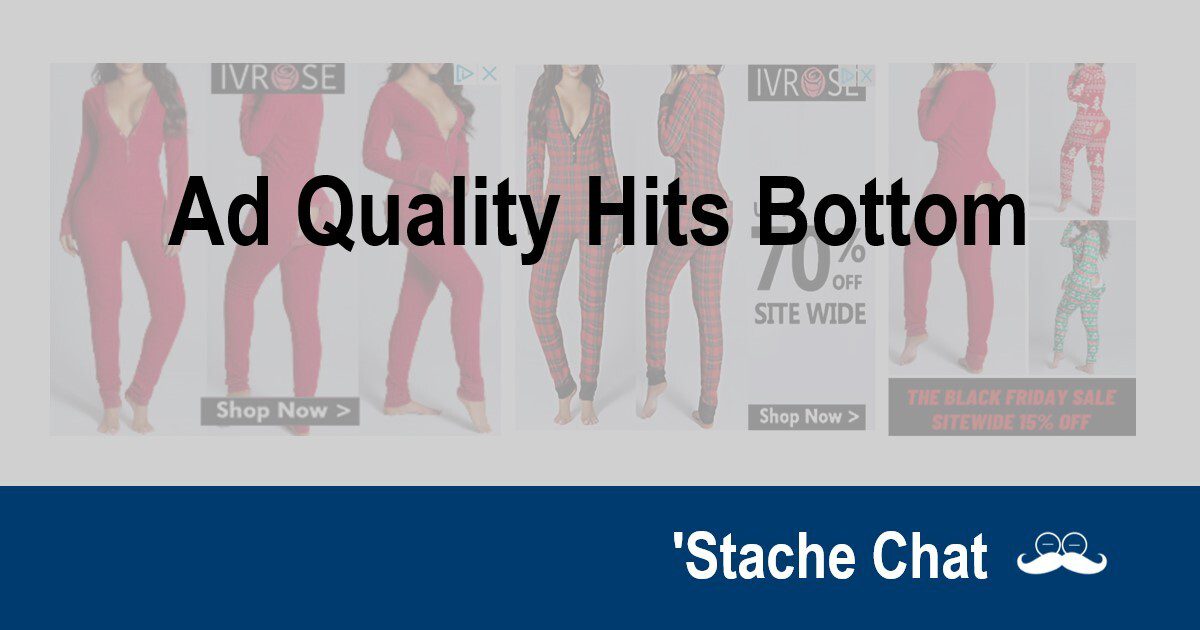
In his new monthly column, Product Marketing Lead Gavin Dunaway (known as the Ad Tech Stache by people besides his mother) argues that bare-butt pajama ad seen just about everywhere this holiday season highlights the need for better brand safety controls—for publishers.
It wouldn’t be the holiday season without some programmatic advertiser getting cheeky—literally, this year. You might have noticed a banner on several premium publishers for a onesie pajama with a female model illustrating what happens when the button-up flap on the buttocks malfunctions.
Yup, a half moon cracked its way onto publisher pages far and wide, as well as other premium crevices of the Internet. As Vice Media notes, a lot of people reading the intriguing tale of the romance between a journalist and notorious “pharma bro” Martin Shkreli found the ad butting in every few paragraphs. My AdTech Twitter peeps were sharing screenshots with commentary along the lines of, “Great—now that butt is following me around.” (Especially if, like me, your curiosity got the better of you and you gave it a click.)
The ads are coming from retargeting campaigns from a variety of e-commerce sites (not just IVRose, which is getting the most attention), some of them specializing in “fashionable” (read: provocative) attire. They appear to be targeting users that have shown some interest in “women’s clothing” and “adult” content. I guess I made the target group when looking for gifts for my wife (I hadn’t considered spicy PJs but now… WOW, RETARGETING WORKS!).
After seeing pages littered with cheeks, surely ad ops pros mumbled, “Um, does this break our ad quality standards?” Unfortunately, deciding what crosses the line into “bad ad!” territory is very subjective—and is often decided when fiery user complaints flood inboxes.
You can try to put metrics to it—The Media Trust’s Head of Marketplace Innovation Cory Schnurr has one client with a sharp cutoff on bum skin—30% of a cheek in an ad. 29%? OK. 30%—scram!
Besides being clearly biased against larger posteriors, how do you quickly measure whether a raw buttock takes up 30% of a creative? We imagine it requires a protractor and special cheek-to-butt metrics. (A fun party game for your Zoom holiday calls: Can you tell the difference between 29% and 30% of an entire butt cheek?)
Strange Creative Is Coming
Of course it’s not that simple for most publishers, particularly when you loop in the open programmatic marketplace—and especially now when publishers are trying to make up for terrible second quarters. Publisher revenue teams have been walking an even more delicate tightrope this year between user experience and revenue optimization. What do you do about Covid mask ads that smell funny? And that doesn’t even get into the really weird stuff that makes it through the programmatic pipes.
Around Halloween 2019, I was hit with an ad for a clam shell mask that remarkably resembled genitalia—while simply trying to learn about a California Consumer Privacy Act update on an industry rag. (After seeing that monstrosity, I was more concerned about protecting my eyes than my data.) The ad was served programmatically and featured the AdChoices icon—I was targeted because the advertiser also sold guitar equipment. (I SWEAR!)
My guess is the advertiser pulled something similar to e-commerce site Wish.com, which for a while in 2017 flooded the web—and especially mobile apps—with some truly bizarre creative. These included advertisements for cat blindfolds, golf-club-shaped cue tips, and many, many, many drug- and sex-oriented products a premium publisher would fear to see on the least trafficked page on their website.
Turns out, Wish.com uploaded its massive catalog of items—even the less family-friendly ones—into its buying platform (Facebook, as The Daily Beast story notes) and set it loose into the programmatic wilds. The company’s advertising appears to have become more strategic in the years since.
But this is a big issue for publishers. In addition to malevolent actors trying to take advantage of the open programmatic ecosystem and the publisher hustle for revenue, there are a lot of careless advertisers out there not putting much thought into their creative—and the potential user experience headaches they could cause for publishers.
Pubs Have Brands, Need Safety
The industry has cracked down on creative size through Google’s heavy-ad blocking initiative with some unwanted side effects, but creative content is a much thornier issue since it’s so subjective.
How many publishers saw that butt cheek ad and shrugged? I’m not judging their choice—the first time I saw it, I simply rolled my eyes at the hackneyed titillation. Honestly, it’s a mild ad, and most of the frustration or amusement on Twitter was due to the campaign’s loose exercise of frequency capping.
Too many brand safety conversations revolve around advertisers afraid of their ads being adjacent to “objectionable” content. But publishers also have brands to protect, and with programmatic monetization, that can be a near-Herculean task.
When consumers start sending in fiery emails complaining about butt cheeks on the homepage, a publisher’s best option is to call up all their demand partners (a number that’s likely in the double digits) and say, “No more cheeky pajama ads!” Even then, a stray glute might pass through enough reseller hops to make it on your site.
This is a large initiative we have at The Media Trust—how do we offer publishers more control over the quality of advertisers and ads appearing on their sites? A key part of the solution is going up the chain to demand partners and installing a creative categorization regime.
As we perform ad quality due diligence for SSPs, exchanges, and DSPs, we offer the ability to categorize ad creative—including political, alcohol, and adult… As well as provocative, which offers differentiation between porn ads and suggestive creative. The level of differentiation required is intense—consider that some publishers are fine with CBD ads but give a big thumbs down to THC creative, while others are cool with THC and want nothing to do with CBD because they question its usefulness.
Policy Before Tools
With categorization in place up the chain, publishers can better filter creative coming through the open marketplace. But first, they need to assess their creative risk profile by understanding what falls in those various categories. The best way to use filtering capabilities is to have a well-thought-out policy in place, and shared with demand partners.
Especially as the depreciation of the third-party cookie upends the programmatic space, the publisher brand will be more valuable than ever. Pubs need tools to protect their integrity.
No butts about it.



